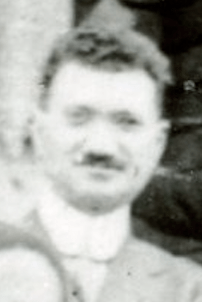
Asheville Citizen-Times, 24 January 1923.
One hundred years ago, the North Carolina Secretary of State awarded a charter to the Patriotic Order of Ethiopians of America, Inc., Wilson. Other than Order’s award to Ben Mincey for bravery, I have found no further mention of the P.O.E.A., and the Secretary of State’s office has no record of the charter. (I’ve added them to the very long list of late nineteenth/early twentieth-century Wilson County African-American fraternal organizations.)
——
John A. Mebane was the son of Union soldier, educator and Reconstruction-era state legislator George Allen Mebane and Jennie Sanderson Mebane.
In the 1910 census of Elizabeth City township, Pasquotank County, North Carolina: house painter J.A. Mebane, 25; wife Rachel, 24; and children Jennie A., 6, Edmond A., 3, and Julian H., 1.
In 1918, John Alexander Mebane registered for the World War I draft in Perquimans County, North Carolina. Per his registration card, he was born 24 July 1884; was a minister at First Colored Baptist Church; and his nearest relative was Rachel Mebane.
Hattie Esther Mebane was born 10 May 1918 in Hertford, Perquimans County, N.C., to Rev. John A Mebane, 34, of Windsor, N.C., and Rachel Snowden, 33, of Snowden, N.C. She was the eighth of eight children.
Robert A. Mebane was born 10 July 1920 in Crawford township, Currituck County, N.C., to John A Mebane, 34, of Hertford County, N.C., and Rachel Snowden, 33, of Currituck County. He was the ninth of nine children.
In the 1920 census of Hertford, Perquimans County, N.C.: Baptist minister John A. Mebane, 33; wife Rachael, 34; and children Jennie A., 15, Edmund A., 13, Julian H., 11, Vivian B., 8, Myrtle M., 7, John A., Jr., 5, Margaret R., 3, and Ester B., 8 months.

Julian Mebane, The Normal Light, yearbook of Elizabeth City State Normal High School (1925).
On 12 June 1927, Julian H. Mebane, 23, of Elizabeth City, son of John A. and Rachel Mebane of Wilson, married Ollie McLaughlin, 19, of Zebulon, N.C., daughter of John W. and Julia McLaughlin of Zebulon.
In the 1928 Hill’s Wilson, N.C., city directory: Mebane Jno A Rev (c; Rachel) pastor Mt Sinai Missionary Baptist Ch h 1008 Woodard av. Also: Mebane Vivian B (c) student h 1008 Woodard av
In the 1930 Hill’s Wilson, N.C., city directory: Mebane Jno A Rev (c) H 308 Hackney
In the 1930 census of Manhattan, New York, New York: Rachel Mebane, 43, odd jobs house worker, and her children Vivian, 19, laundress, Myrtle, 18, restaurant waitress, John, 16, pin setter at bowling alley; Margaret, 13, Esther, 11, Robert, 9, and Omega, 2.
Walter Mebane was stillborn 6 August 1931 in Rocky Mount, N.C. Per his death certificate, he was born in Rocky Mount to John A. Mebane of Rocky Mount and Henrietta Foster of Wilson and was buried in Nash County.
William Allen Mebane was born 7 July 1933 in Tarboro, Edgecombe County, to John A. Mebane and Henrietta Foster.
Vivian Mebane died 30 March 1938 at Riverside Hospital, Bronx, New York. Per her death certificate, she was born 27 May 1910 to John Mebane and Rachel Snowden.
In the 1940 census of Tarboro, Edgecombe County, N.C.: church minister John A. Mebane, 54; wife Henrietta, 38, registered nurse; and children William A., 6, and Florence, 5.
Grace Mebane died 7 February 1940 in Tarboro, North Carolina. Per her death certificate, she was born 11 April 1926 in Petersburg, Virginia, to John Mebane of Bertie County, N.C., and Henrietta Foster of Wilson County; and was buried in Wilson, N.C.
Margaret Rachel Mebane died 18 November 1942 in Manhattan, New York, New York. Per her death certificate, she was born 30 September 1893 in North Carolina to Edmund and Hester Snowden; lived at 54 Morningside Avenue; and was married to John A. Mebane. [Surely, they were divorced. They were certainly long separated, and John Mebane had remarried.]
In the 1950 census of Tarboro, Edgecombe County, N.C.: painter John A. Mebane, 64; wife Heneretta A., 48, public health nurse; and daughter Florence Y., 14.
Henrietta Alline Foster Mebane died 2 June 1950 in Tarboro, Edgecombe County, N.C. Per her death certificate, she was born 24 August 1901 in North Carolina to Walter Foster and Nettie Young; worked as a nurse; was married; and was buried in Rountree Cemetery “near Wilson, N.C.” John A. Mebane was informant.
Rev. John A. Mebane died 27 December 1974 and was buried next to his wife Henrietta in Rest Haven Cemetery, Wilson. [Presumably, Henrietta Foster Mebane’s body was exhumed from the Foster family plot and re-interred in Rest Haven.]
- W.E. DuBissette — this was surely Dr. Michael E. DuBissette, who practiced medicine in Wilson during this period.
- Dan Rogers






























